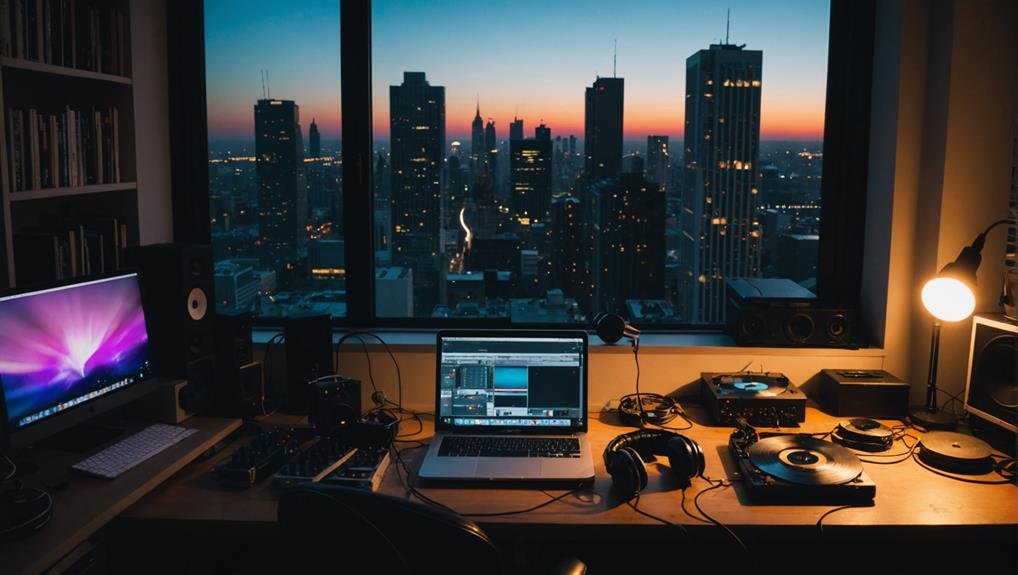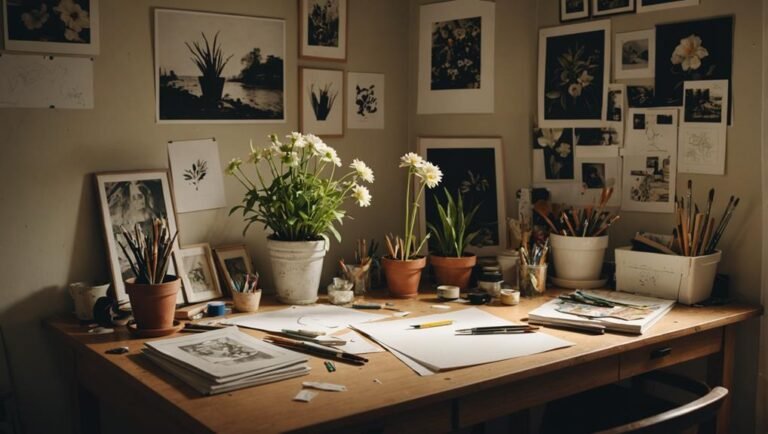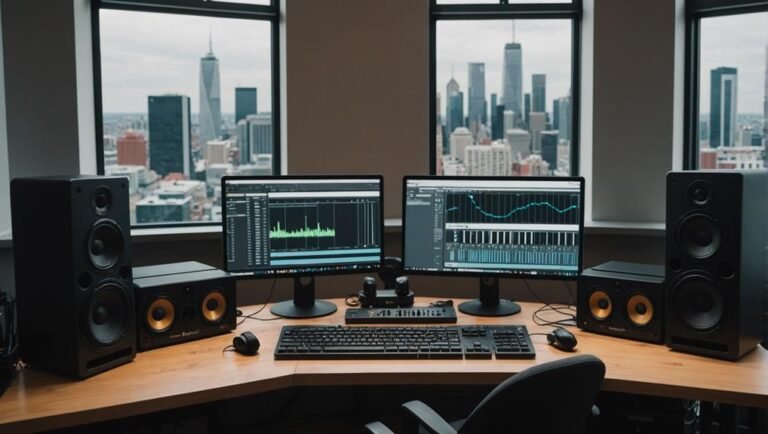You’re sitting on a treasure trove of sonic possibilities, with the sounds of your favorite tracks waiting to be unearthed, rearranged, and transformed into something entirely new. From understanding sampling fundamentals to exploring unconventional sources like nature sounds and everyday objects, you’ll reveal creative techniques like chopping, layering, and effects manipulation to craft unique textures and timbres. By mastering advanced editing techniques and building a personalized sample library, you’ll uncover the secrets to transforming samples into instruments and creating original drum kits that set your tracks apart – and that’s just the beginning of your sonic journey.
Key Takeaways
- Mastering sampling fundamentals, including loop and chop sampling, enhances creativity and confidence in bedroom beatmakers.
- Exploring unique sample sources, such as vinyl records, online archives, and everyday objects, expands the sonic palette.
- Creative techniques like chopping, layering, and effects manipulation transform samples into vibrant sounds, pushing creative boundaries.
- Developing a unique sample library by curating hidden gems and exploring unconventional sources reflects individual sound identity.
- Advanced editing techniques, including slicing, dicing, and pitch-shifting, reveal new creative possibilities and distinguish tracks.
Understanding Sampling Fundamentals
You’re about to plunge into the world of sampling, but before you start flipping through crates or browsing online databases, it’s essential to understand the basics.
Sampling is about taking a portion of existing music, manipulating it, and making it your own. There are two primary types: loop sampling and chop sampling.
Loop sampling involves using a continuous section of a track, often with minimal editing. Chop sampling, on the other hand, involves breaking down a sample into individual sounds or phrases and rearranging them.
Understanding these fundamental concepts will help you navigate the world of sampling with confidence and creativity.
Popular Sample Sources to Explore
Crates full of vinyl records, dusty CDs, and digital databases await your digging skills. As a bedroom beatmaker, you’re on a mission to uncover hidden gems and unique sounds to fuel your creativity.
You’ll find plenty of inspiration in classic soul and funk records, where breaks and hooks are ripe for the picking. Jazz and rock albums can also provide an eclectic mix of instrumentation and textures.
Online databases like Freesound and Sample Magic offer a vast library of sounds, from ambient pads to percussive elements.
Don’t forget to explore YouTube and online archives, where you can discover obscure recordings and vintage broadcasts.
The key is to stay curious and keep digging – the right sample can spark a whole new track.
Creative Chopping and Rearranging
Now that you’ve got a treasure trove of samples, it’s time to get creative with them.
One of the most exciting aspects of sampling is chopping and rearranging – taking a sample and breaking it down into individual hits, then reassembling them to create something entirely new.
This is where the magic happens, and you get to put your own spin on the original material.
Try flipping the sample, reversing it, or repeating certain phrases to create a stutter effect.
You can also experiment with granular synthesis, breaking down the sample into tiny grains and rearranging them to create a unique sound.
The key is to experiment and push the boundaries of what’s possible.
Layering for Texture and Depth
Building a rich sonic landscape often relies on layering multiple samples to create texture and depth. You’re not limited to using a single sample to convey your message – combine different elements to craft a unique sound.
Start by selecting samples that complement each other regarding tone and timbre. Then, experiment with layering them in different ways, adjusting levels and panning to create a sense of space.
You might layer a bright, percussive sound with a warmer, more atmospheric one to add complexity. Don’t be afraid to get creative and try unusual combinations – you might stumble upon something truly innovative.
Manipulating Samples With FX
Your sample arsenal is packed with potential, but it’s the application of effects that can reveal their true character.
You can transform a dull, lifeless sample into a vibrant, attention-grabbing sound with the right FX. Reverb adds space and depth, while delay creates a sense of movement and tension. Distortion and overdrive can inject attitude and grit, while filters help you sculpt and refine your sound.
Experiment with different FX chains to create unique textures and timbres. Don’t be afraid to push the limits and create something entirely new.
Unconventional Sample Material
Plunge into the uncharted territories of sampling by experimenting with unconventional sample material.
You’ll be surprised at the unique textures and timbres you can extract from everyday objects. Record the sounds of nature, like birds chirping or water flowing, to create organic, earthy samples.
Experiment with found sounds from your daily life, such as the hum of a refrigerator or the creak of a door.
Even your own voice can be a valuable resource – try recording yourself making strange vocalizations or manipulating your voice through effects pedals.
Building a Unique Sample Library
You’ve got a solid foundation of unconventional sample material, but now it’s time to build a unique library that truly reflects your sound.
This means digging for hidden gems that others might overlook, cultivating your personal taste to curate a distinctive collection, and organizing the chaos to make it all easily accessible.
Digging for Hidden Gems
Scores of producers rely on the same tired sample sources, but not you – you’re on a mission to unearth hidden gems that’ll set your beats apart.
You’re willing to dig deeper, and that’s where the real treasure lies. To get started, try these unconventional sources:
- Obscure vinyl records: Thrift stores, garage sales, and second-hand shops are treasure troves for rare and unusual records.
- Foreign film soundtracks: Explore the sonic landscapes of international cinema to discover unique textures and moods.
- Vintage video games: Remember those 8-bit and 16-bit classics? They’re a goldmine for quirky, nostalgia-tinged samples.
- Public domain archives: Websites like the Internet Archive offer a wealth of public domain recordings, from old-time radio shows to forgotten jazz albums.
Cultivating Personal Taste
As your sampling repertoire expands, so does your distinct sonic identity. You’re no longer just a bedroom beatmaker; you’re a curator of unique sounds. Building a personalized sample library is key to standing out in a crowded musical landscape.
To cultivate your personal taste, explore different genres, eras, and moods. Don’t be afraid to experiment and push boundaries. Remember, the goal is to create something authentic, not to replicate someone else’s style.
| Sampling Approach | Resulting Sound |
|---|---|
| Vintage soul and funk | Warm, nostalgic, and retro |
| Experimental ambient textures | Moody, atmospheric, and futuristic |
| Jazz breaks and swing | Sophisticated, upbeat, and quirky |
| World music and folk | Exotic, earthy, and eclectic |
Organizing the Chaos
With your unique sonic identity taking shape, it’s time to corral the chaos of samples you’ve accumulated.
You’ve got a treasure trove of sounds, but managing them can be overwhelming. It’s crucial to organize your sample library to reveal its full potential.
To build a unique sample library, follow these steps:
- Categorize by instrument or sound type: Group similar sounds together, like drums, synths, or vocals.
- Label and tag samples: Use descriptive labels and tags to identify the sample’s source, key, and tempo.
- Create a folder structure: Set up a logical folder hierarchy to store your samples, making it easy to find what you need.
- Purge unnecessary samples: Remove duplicates, low-quality samples, or those that don’t fit your sonic identity, freeing up space and reducing clutter.
Advanced Sample Editing Techniques
You’re now ready to take your sampling skills to the next level with advanced editing techniques.
By learning to slice and dice audio, pitch and time warp, and re-arrange and re-sequence, you’ll reveal new creative possibilities and transform your samples into unique sounds.
With these techniques, you’ll be able to create complex, layered textures and rhythms that set your tracks apart.
Slice and Dice Audio
Your sample’s potential is hidden in plain sight, waiting to be revealed by advanced editing techniques. Slice and dice audio to uncover the hidden gems within your sample. This process involves breaking down the sample into smaller segments, allowing you to manipulate and rearrange them to create something entirely new.
Here’s how to get started:
- Identify key elements: Pinpoint the most interesting parts of your sample, such as drum hits, melodies, or vocal phrases.
- Create a chop shop: Cut your sample into smaller pieces, ranging from a few milliseconds to several seconds.
- Rearrange and reorganize: Experiment with different arrangements of your chopped samples to create new rhythms and melodies.
- Experiment with effects: Apply filters, reverb, and other effects to further transform your sliced samples into something unique.
Pitch and Time Warp
Now that you’ve sliced and diced your sample, it’s time to take your editing skills to the next level by warping its pitch and time. This advanced technique allows you to manipulate the sample’s melody and rhythm to fit your track’s key and tempo.
You can use pitch-shifting to create interesting harmonies or to make the sample sound more menacing or bright. Time warping lets you slow down or speed up the sample to create unique textures or to match the tempo of your track.
Be careful not to overdo it, as drastic changes can sound unnatural. Experiment with subtle adjustments to create a unique sound that’s all your own.
Re-Arrange and Re-Sequence
Taking your sample to the next level involves re-arranging and re-sequencing its components to create a unique sound that complements your track.
You’re no longer limited to the original structure of the sample – it’s time to get creative!
By re-arranging and re-sequencing, you can:
- Create a new rhythmic pattern by reordering the drum hits or percussion elements.
- Transform the melody by re-pitching or re-timing specific notes or phrases.
- Add tension and release by re-sequencing the sample’s dynamics, creating a sense of build-up and drop.
- Experiment with micro-editing by re-arranging individual sounds or textures within the sample.
Creating Original Drum Kits
Crafting original drum kits is an essential step in separating your sound from the masses and injecting personality into your productions. You can’t rely on pre-made kits and expect to stand out. By creating your own, you’ll reveal a unique sonic identity that sets your tracks apart.
| Drum Type | Sound Characteristics | Inspiration Sources |
|---|---|---|
| Kick | Deep, punchy, boomy | 80s funk, trap, drum and bass |
| Snare | Crisp, sharp, cracky | 90s hip-hop, rock, indie |
| Hi-Hat | Bright, shuffling, metallic | Jazz, fusion, electronic |
Explore different genres, experiment with layering and processing, and don’t be afraid to get creative. Remember, your drum kit is a sonic fingerprint – make it your own!
Transforming Samples Into Instruments
With your unique drum kit in place, it’s time to breathe life into individual samples, transforming them into instruments that will elevate your productions.
You’ve got the foundation, now it’s time to get creative and make those samples shine.
Here’s how to transform your samples into instruments:
- Tune and pitch: Adjust the pitch to fit your track’s key, and experiment with different tunings to create unique textures.
- Layer and stack: Combine multiple samples to create a rich, full sound that cuts through the mix.
- Add effects: Experiment with reverb, delay, and distortion to add depth and character to your samples.
- Process and resample: Run your samples through a drum machine or effects processor to create new, interesting sounds.
Frequently Asked Questions
How Do I Avoid Sample Clearance Issues With Major Labels?
When working with samples, you’ll want to clear them ASAP to avoid label headaches – research the original creators, get permission, or use public domain resources to guarantee your beats are legally sound and ready for the masses.
Can I Use Samples From Youtube Videos or Podcasts?
You can’t use samples from YouTube videos or podcasts without permission; it’s copyright infringement. You’ll need to get clearance from the original creators or risk legal issues, so it’s best to create your own content or use royalty-free samples instead.
Are There Any Free or Affordable Sample Clearance Services?
You’re not alone: 70% of producers struggle with sample clearance! You can breathe easy, though – services like Tracklib, SampleMagic, and even some lawyers offer affordable clearance solutions, so you can focus on creating, not worrying about legal woes.
Can I Resell or Distribute Samples I’ve Purchased Online?
You’re likely wondering if you can resell or distribute samples you’ve purchased online. Typically, no, you can’t resell them as is, but you might be allowed to use them in your own music, depending on the seller’s licensing terms.
Do I Need to Clear Samples for Non-Profit or Charity Projects?
You’re wondering if you need to clear samples for non-profit or charity projects? Typically, yes, you still need permission or a license, as copyright laws apply regardless of the project’s purpose, but there might be some flexibility, so it’s crucial to research and understand the specific requirements.
Conclusion
You’ve opened the treasure chest of sampling secrets, and now it’s time to forge your own sonic sword. Think of your samples as raw materials, waiting to be melted, molded, and shaped into a masterpiece. As you wield your creative power, remember that the greatest beatmakers are master alchemists, transforming humble fragments into gold. So, don’t just sample – transmute.



